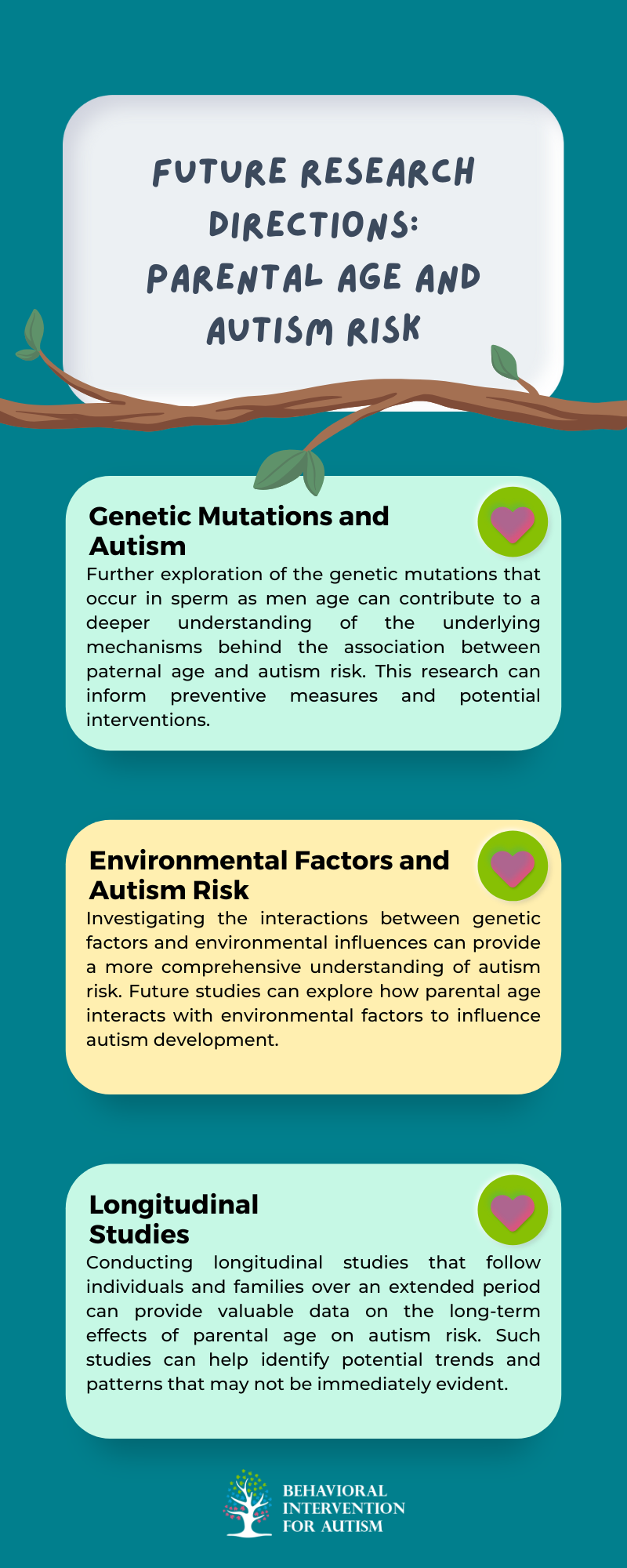
Table of Contents
The impact of parental age on the risk of Autism Spectrum Disorder (ASD) has been a subject of interest and research. Understanding the relationship between parental age and autism can provide valuable insights into the factors contributing to the development of ASD. We’ll examine how parental age influences autism and the potential risks linked to having children later in life.
Impact of Parental Age on Autism
Research has shown that parental age can influence the risk of autism in children. The chance of having ASD for children born to parents in their 30s is up to 10% higher than parents who are 25 to 29 years old. The risk becomes even higher when parents are in their 40s or 50s, with a 50% increase in the chance of having ASD compared to younger parents.
These findings suggest that there may be a correlation between parental age and the occurrence of autism. However, it’s important to note that parental age is just one of many factors that contribute to the development of ASD. Genetic mutations, environmental factors, and other variables also play a role in determining the risk of autism in children.
Risks for Autistic Children of Older Parents
Children born to older parents, particularly those in their 40s and 50s, have been found to have a higher risk of autism compared to children born to younger parents. ASD rates were 66% higher in children of fathers over 50 and 28% higher in children of fathers in their 40s, compared to those with fathers in their 20s. Likewise, children of mothers in their 40s had a 15% higher incidence of ASD compared to those with mothers in their 20s.
Moreover, the risk of ASD also increases when both parents are older and when there is a significant age gap between the two parents. ASD rates were highest when the father was aged 35-44 and his partner was 10 or more years younger. These findings suggest that both maternal and paternal age can contribute to the risk of autism in children.
The higher risk of ASD associated with older parents could be attributed to genetic mutations that become more prevalent as individuals age. Genetic mutations in sperm, which increase with advancing paternal age, have been suggested as a potential explanation for the higher risk of ASD in children born to older fathers.
Understanding the relationship between parental age and autism risk is essential for raising awareness and promoting early interventions. It is important for individuals considering parenthood to be aware of the potential risks associated with parental age. However, it’s crucial to note that while parental age may contribute to the risk of ASD, it is not the sole determining factor.
Understanding Autism Development
To gain a deeper understanding of the relationship between parental age and autism, it is important to explore the mechanisms of autism spectrum disorder (ASD) risk and the association between parental age and autism.
Mechanisms of ASD Risk
The development of ASD involves a complex interplay of genetic and environmental factors. Genetic mutations are considered one of the key mechanisms contributing to ASD risk. These mutations can occur spontaneously or be inherited from parents. Research suggests that there may be specific genetic mutations in sperm that become more prevalent as a man ages, which could contribute to ASD risk.
Along with genetic factors, environmental factors also contribute to the development of autism. The exact environmental factors that contribute to ASD risk are still being investigated, but it is believed that they interact with genetic vulnerabilities to increase the likelihood of developing autism. The study of environmental factors related to parental age and autism risk is an ongoing area of research.
Association Between Parental Age and Autism
Several studies have examined the association between parental age and autism risk. These studies have found that both maternal and paternal age can independently influence the risk of having a child with autism. Older parents, particularly older fathers, are at a higher risk of having children with autism.
Research has also explored the impact of parental age gaps on autism risk. Studies have shown that relatively large age gaps between parents can increase the likelihood of having a child with autism. One study that analyzed more than 5.7 million children in five countries found increased autism rates among children whose parents have significant age gaps.
It is important to note that while parental age has been identified as a significant factor in autism risk, it is not the sole determinant. The development of autism is complex and multifactorial, involving a combination of genetic and environmental influences. Further research is needed to fully understand the mechanisms by which parental age and other factors contribute to the development of autism.
Gaining a deeper understanding of the mechanisms underlying ASD risk and the association between parental age and autism can significantly enhance our knowledge of this complex condition. This insight helps inform future research and could lead to improved strategies for autism prevention and intervention.
Implications for Autism Prevention
Understanding the implications of parental age on autism risk is crucial for autism prevention efforts. By raising awareness and taking certain factors into consideration, individuals and healthcare professionals can work together to minimize the risk of autism in future generations. Two important aspects to consider are the importance of parental age awareness and future research directions.
Future Research Directions
While significant progress has been made in understanding the relationship between parental age and autism risk, there is still much to learn. Future research in this field can provide valuable insights into autism prevention strategies. Some potential areas for further investigation include:

Expanding our understanding of how parental age affects autism relies on ongoing research. As we deepen this knowledge, we can drive more effective public health initiatives, shape targeted educational programs, and enhance support services. These advancements are crucial for reducing autism risk and improving the well-being of individuals and families impacted by autism.
At Behavioral Intervention for Autism, we are committed to providing high-quality ABA programs in Florida to support those affected by autism. Our dedicated team offers personalized care and evidence-based therapies to ensure the best outcomes.
For more information or to get started with our services, contact us today.
- 9 Common Obsessions of Children With Autism You Should Know - February 25, 2025
- What is Neurodiversity? A Guide to Embracing Differences - February 25, 2025
- Understanding Hyperfocus in Autism: What It Means and Why It Happens - February 25, 2025
